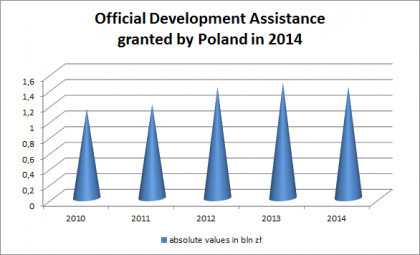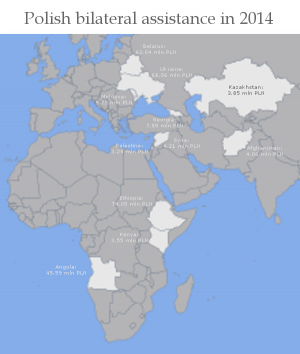Polish Aid 2014 in numbers
In 2014, Poland provided PLN 1.425 billion for Official Development Assistance (ODA), which included PLN 1.166 billion, i.e. 82% of all funds, spent for multilateral cooperation. PLN 259 million (18%) was spent on bilateral cooperation. The amounts spent on development cooperation amounted to 0.09% of Poland’s Gross National Income (GNI).
The largest part of Polish development assistance spent via multilateral institutions and organisations fed the European Union funds intended for external development assistance. In 2014, the value of Poland’s share in those activities amounted to PLN 1.070 million. It included a part of the contribution to the EU budget, which was dedicated to the above-mentioned purpose (PLN 898 million[1]) and the payment for the European Development Fund (EDF) (PLN 172 million[2]) which is the main non-budgetary instrument of the European Union used to finance the cooperation with countries in Africa, the Caribbean, and the African, Caribbean and Pacific Group of States (ACP) and Overseas Countries and Territories (OCTs).
Entities acting within the United Nations System were provided with PLN 60 million.
In 2014, the development assistance was based on the Multiannual Development Cooperation Programme 2012–2015. Pursuant to the programme, Polish assistance was provided within geographical and thematic support areas.
Geographical areas were divided into two groups. The first group comprised the six countries of the Eastern Partnership: Armenia, Azerbaijan, Belarus, Georgia, Moldova, and Ukraine. In this case, the purpose of Polish assistance is supporting the continuous and stable functioning of democratic systems, ensuring that human rights are observed, and contributing to effective system transformation.
The other group includes selected countries of Africa, Asia, and the Middle East. It comprises eight countries from Eastern Africa (Burundi, Ethiopia, Kenya, Rwanda, Somalia, South Sudan, Tanzania, and Uganda), two countries from Central Asia (Kyrgyzstan and Tajikistan), and Palestine. The countries listed above suffer from a high level of poverty.
The main recipients of Poland’s bilateral assistance in 2014 were: Ethiopia (PLN 74.05 million), Ukraine (PLN 68.06 million), Belarus (PLN 63.04 million), Angola (PLN 45.59 million), Moldova (PLN 9.75 million), Georgia (PLN 7.88 million), Syria (PLN 4.21 million), Afghanistan (PLN 4.06 million), Kazakhstan (PLN 3.85 million), Kenya (PLN 3.55 million), and Palestine (PLN 3.23 million).
Since the implementation of the 2012–2015 Programme, Polish development assistance has been concentrated on two thematic support areas, i.e. democracy and human rights, and system transformation.
Education has also been an important aspect of Polish development assistance. In 2014, the amount spent on education, including scholarships, reached PLN 98.5 million. Another significant component of ODA was supporting the government sector and the civic society (PLN 47.1 million).
The funds that Poland contributed in 2014 to humanitarian activities as a part of ODA exceeded PLN 18 million. The assistance granted to Ukrainians amounted to more than 30% of the funds, while 22% was provided to Syrian refugees and for the purpose of counteracting the crisis in Syria. The support was also granted to flooded areas in Bosnia and Herzegovina and Serbia (the assistance amounted to PLN 1.11 million).
In 2014 the value of bilateral development assistance exceeded PLN 259 million. After deducting the value of loan agreements, the value of bilateral assistance reached PLN 207 million. The main distribution channels included universities, and scientific and R&D institutions. Almost 43% of funds intended for bilateral development assistance was provided in this way. The second largest group consisted of institutions in the public finance sector, mostly ministries and foreign offices, which spent more than 28% of the funds. Non-governmental organisations which implemented actions amounting to almost 24% of bilateral assistance played an important role, as well. The remaining funds, 5.14% of the value of bilateral ODA minus loan agreements, were spent via international organisations.
[1] Poland pays one contribution to the EU budget. The contribution is not divided into particular programmes, funds, or instruments. Poland’s share in the Official Development Assistance of the European Union is calculated as follows: the percentage of the EU budget that is contributed by Poland can be calculated on the basis of the EU budget amount and the amount contributed by Poland. Assuming that Poland’s share in the Official Development Assistance of the European Union is the same as its share in the entire EU budget, it can be calculated on the basis of the data on the EU budget implementation. Estimates on budget implementation are updated as new reports and EU reports are filed, and therefore can be subject to change. The final data on the EU budget implementation for 2014 show that Poland’s share in the EU expenditure for the Official Development Assistance amounted to PLN 898 million.
[2]The amounts contributed by the Member States to the European Development Fund is specified by the European Commission each time based on the estimated financial needs related to the activities provided for in a given edition of the Fund. Funds unused in a given edition are not returned to their contributors. Instead, they are credited towards the amount due for the following Fund edition.

